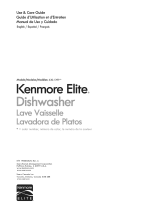
117
Dishwasher
seems to run a
long time
1. Incoming water is not warm enough.
2. Cycle time can vary due to soil and water con-
ditions.
3. Rinse agent dispenser is empty.
4. Dishwasher connected to cold water sup-
ply.
NOTE: Refer to “Wash Cycle Information” sec-
tion of this manual for typical cycle lengths.
1. Before starting a cycle, run hot water faucet at the sink
closest to the dishwasher.
2. Sensors in the dishwasher automatically increase the
cycle time to ensure a good wash when heavy soil is
detected.
3. Add rinse agent.
4. Verify dishwasher is connected to hot water supply
plumbing.
Dishes are not
getting clean
enough
1. Spray arm movement obstructed.
2. Spray arm nozzles clogged.
3. Improper use of detergents.
4. Filters could be clogged.
5. Dishes are nested or loaded too close
together.
6. Selected wash cycle is not suitable for
food soil conditions.
1. Ensure that spray arm movement is not blocked by
hand rotating spray arms before starting cycle.
2. Remove the spray arms and clean according to the
“Care and Maintenance” section of the manual.
3. Increase or decrease detergent depending on the water
hardness (refer to Table 1).
4. Clean the filters according to the “Care and Mainte-
nance” section of the manual.
5. Rearrange load such that water spray can reach all
items in the dishwasher - see “Loading the Dishwasher”
section of the manual.
6. Refer to “Wash Cycle Information” section of the manual.
Dishes are not
getting dry
enough
1. Rinse agent dispenser is empty.
2. Improper loading of dishes.
3. Selected cycle does not include drying.
4. Extra Dry Heat is not activated.
NOTE: Plastic or Teflon do not typically dry as
well as other items due to their inherent prop-
erties.
1. Add rinse agent - the use of rinse agent improves dry-
ing.
2. Rearrange load to ensure items are not nesting (see
“Loading the Dishwasher” section of the manual).
3. Rinse and Hold setting does not include drying.
4. See the “Operating the Dishwasher” section of this
manual to learn how to activate Extra Dry Heat.
Odor
Note: Water
testing is done in
the factory.
Occasionally
water may still
appear in the
dishwasher at
purchase which
may create an
odor.
1. Food debris is present at the bottom of
the dishwasher.
2. Food particles are present near the door
seal.
3. Dishes left in unit too long before running a
cycle.
4. Residual water is present at the bottom
of the dishwasher.
5. Drain hose is obstructed.
1. Remove the filters and clean according to the “Care
and Maintenance” section of the manual.
2. Refer to “Care and Maintenance” section of the manual.
3. Run a Rinse and Hold cycle if you do not intend to
immediately wash the dishes.
4. Ensure the unit has completely drained from the last
cycle.
5. Remove any obstructions from the drain hose by calling
qualified personnel.
NOTE: If odor still persists, run the Normal/Regular cycle until
it flushes and interrupt the cycle and place an 8 oz. cup of dis-
tilled white vinegar solution on the upper rack and then finish
the cycle.
Dishwasher not
filling with
water
1. Restriction in the water supply system.
2. Previous wash cycle was not completed.
3. Delay start is active.
4. Household water supply turned off.
1. Ensure that the water supply valve (typically located
under kitchen sink) is open and check that the water sup-
ply line has no kinks or clogs.
2. Refer to the “Operating the Dishwasher” section of the
manual.
3. Cancel the delay start or wait until delay start time
completes.
4. Turn household water supply on.
Water leaks 1. Suds.
2. Door seal could be pulled away from
track.
3. Condensation vent is blocked.
4. Improper installation.
1. Wrong type of detergent results in suds and leaks - use
only dishwasher detergents. If suds still persist, add one
tablespoon of vegetable oil at the bottom of the dish-
washer and run the desired cycle.
2. Ensure the door seal is in the track.
3. Ensure that condensation vent is not blocked.
4. Have proper installation verified by qualified personnel
(water supply, drain system, leveling, plumbing).
Problem Cause Action




















